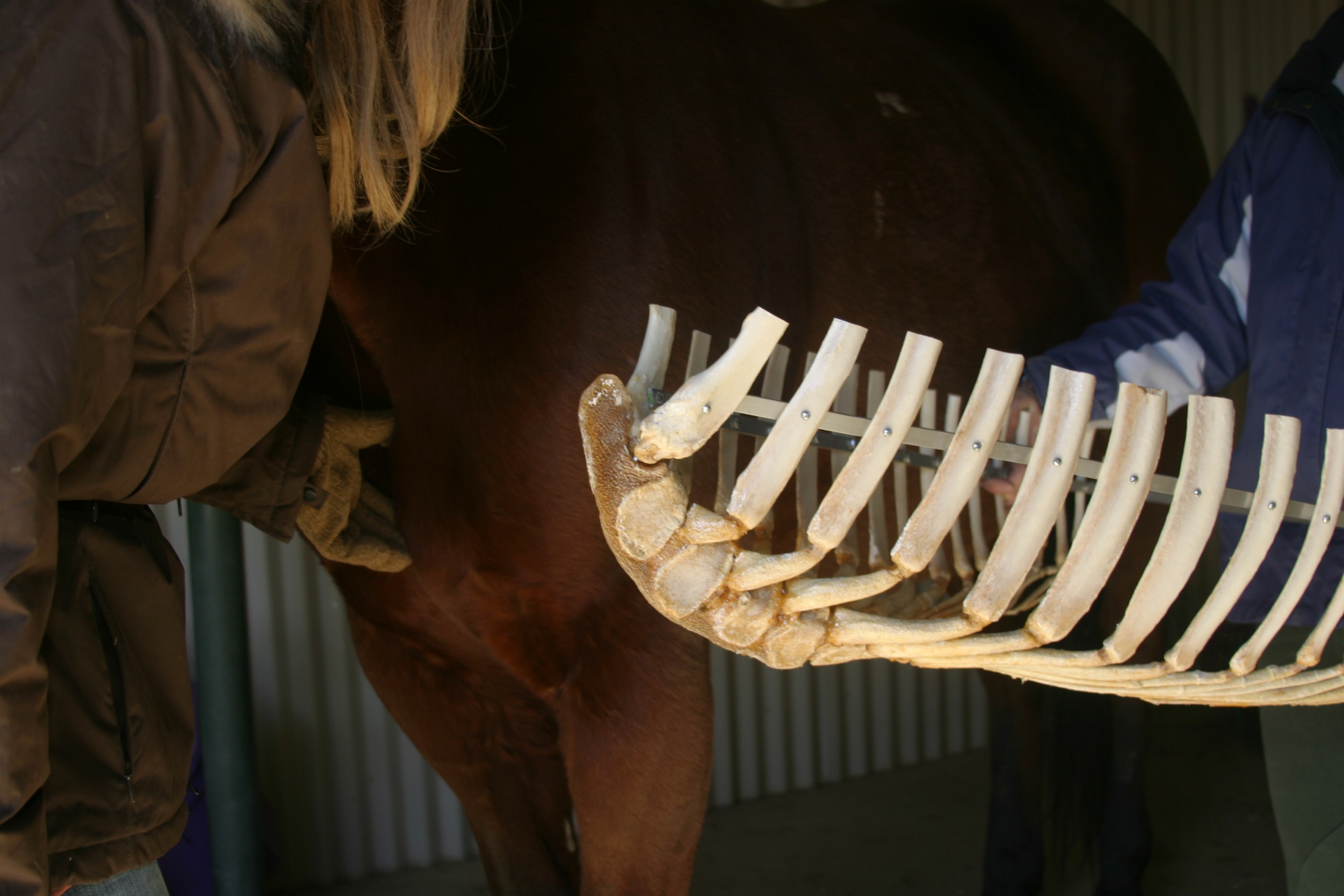Girthy Horse? Simple Steps Make Saddling a Pleasure
Jul 03, 2019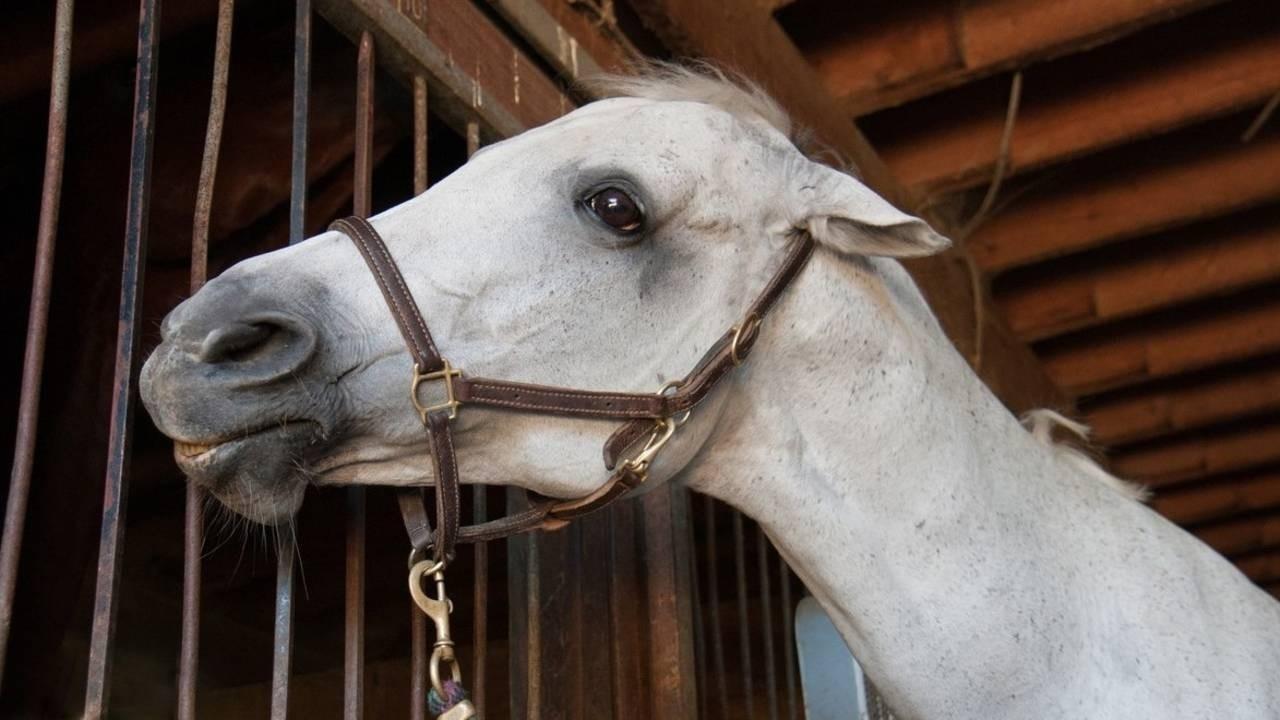
Does your horse pin his ears when you tighten the girth? Does he get grumpy, swish his tail or threaten to bite or kick when you cinch him up? Does your horse seem to hold her breath (“blowing up” or “bloating”) when you’re tacking her up?1
Any of those reactions would fit the definition of a “girthy” or “cinchy” horse. Cinchy horses are so common that many equestrians think nothing of it. But resistance during tacking up can set the tone for your whole ride, and lead to diminished equine performance too.
Tying your horse up short may prevent you from being bitten, and disciplining your horse may discourage the biting, kicking, or tail swishing, but neither method will improve how your horse feels about saddling. In fact, punitive measures usually increase tension in your horse’s mind and muscles.
That’s no way to build a trusting relationship with your horse! Plus, it can lead to diminished performance and a sour attitude. But if you take some time now to make tacking up enjoyable to your horse, it can improve your horse’s attitude and performance, resulting in a happier, more willing equine partner for a lifetime.
And the good news is that it is not difficult to do. In this article, I’ll explain step-by-step how I helped transform a reluctant, girthy horse into a happy, willing partner.
Before we begin, it’s essential to determine if a medical condition is causing your horse to be cinchy. For example, sensitivity in the girth area is thought to be a symptom of equine ulcers. Or your horse could have a painful injury in her back, sternum or ribs. Dental problems can also cause a horse to dislike tacking up. Please have your veterinarian do a thorough examination of your horse before you proceed.
The next step is to make sure that all tack, including the bridle, fits properly and is comfortable for your horse. Have a professional saddle-fitter check the fit, comfort and placement of your horse’s saddle. And make sure that a competent hoof trimmer or farrier has balanced your horse’s hooves.
In addition, you need to carefully and honestly review the work you do with your horse. Are you sitting crooked on your horse? Are your aids excessive? The work too demanding or monotonous? Your horse may object to being tacked up because he knows what is coming next!
Lessons with an experienced, positive trainer and sessions with a Feldenkrais Method® Practitioner would be a useful starting point to make sure that you are not the cause of your horse’s discomfort.
Once you’ve ferreted out the cause of your horse’s girthiness, we can help him change his habitual reaction to saddling. And as someone who has worked professionally with horses and riders for over 25 years, I can say that helping horses not only tolerate cinching, but actually enjoy it, is both fun and extremely satisfying!
Are you excited about that prospect? Then please read on to learn how I helped an unhappy, cinchy Appaloosa discover that tacking up could be a pleasant, relaxing experience.
First, let’s start with some basic equine anatomy. You may be wondering what that thing in the photo below has to do with tacking up your horse. Well, it has a lot to do with it!

That funny-looking thing in the photo above is an equine sternum, or breastbone, accompanied by the costal cartilage and ribs. The ribs in this specimen have been cut off, but they normally continue on up to attach to the horse’s spine, as the photo below of an entire equine skeleton shows.
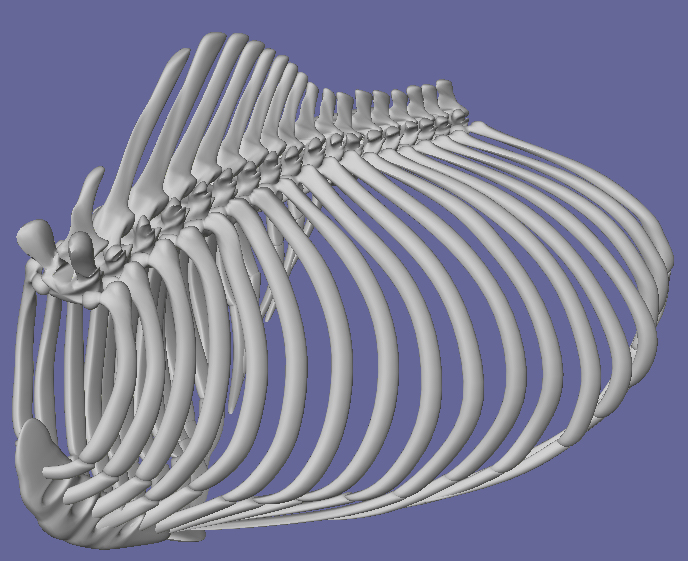
Most riders don’t give much thought to their horse’s sternum. They may pay attention to their horse’s legs, back and neck, but they don’t realize that if their horse’s sternum is restricted, it will negatively impact how the horse is able to use those other parts.
This can manifest as one or more of the following: a tight, hollowed back, shortened stride length, lack of impulsion, difficulty in collection and bending, or overall stiffness. So while the movement potential of the sternum and ribs might be small in relation to other parts of the horse’s body, it is important.
That’s because the sternum and ribs affect many different parts, including the neck, back, shoulders and hindquarters. Restriction in one part restricts the others. Dr. Moshe Feldenkrais, the originator of the Feldenkrais Method®, taught that the more parts of the body that are free to move, the more efficiently effort is distributed throughout the body.
This reduces wear and tear on joints and muscles and improves comfort and athletic performance. (Please read my article, The Secret to Rounding Your Horse’s Back to learn more about the important role that the rib cage plays in your horse’s well-being and performance.)
What I have discovered is that many horses, especially those that dislike being girthed up, have less than optimal movement in their sternum and ribs. And the more they tense up while being saddled, the more restricted and uncomfortable this area becomes.
Conversely, the freer the horse’s ribs and sternum are, the more comfortable girthing up can be. And this ease of movement contributes to improved attitude and performance under saddle as well.
Horses inhibit the movement of their sternum and ribs for any number of reasons, but previous bad experiences with being saddled or ridden probably top the list.
Expecting discomfort, the horse develops the habit of contracting the muscles around the sternum and ribs in an attempt to minimize the discomfort or as a natural response to anxiety.
A vicious cycle can arise, since the more restricted the rib cage is, the more uncomfortable the horse feels when she is girthed up and ridden, so the more she contracts her muscles to protect herself. That is why it is important to interrupt this anxious habit and offer the horse relaxation in its place.
So what can you do to keep your horse happy and comfortable with saddling? Or what can you do if your horse is already unhappy about being girthed up? Don’t despair!
I use gentle, hands-on techniques (called Debono Moves) that bring improved awareness to the sternum, ribs and spine. Most horses find Debono Moves enjoyable and relaxing, so when they are done as part of the saddling process, the horse begins to associate saddling with pleasure.
In addition, the improved movement through the rib cage helps free up the neck, back and legs, so your equine partner can perform more easily and comfortably.
We owe it to our horses to make the process of handling, saddling and riding them to be as comfortable as possible. And your horse will be better able perform his job when he isn’t creating physical and emotional resistance to minimize discomfort.
Resistance to saddling can lead to training problems and contribute to restricted movement. Conversely, enjoyable saddling sets for the stage for harmonious riding experiences and improved athletic performance. And all horses deserve that!
Points to Remember:
- Symptoms of cinchiness/girthiness include: pinned ears, swishing tail, threatening to bite or kick, tensing muscles, holding the breath and “blowing up with air.” Some symptoms are subtle. Observe your horse closely.
- Girthiness can set the tone for your ride, since your horse is in a resistance mindset. Disciplining your horse can increase your horse’s physical and mental tension. Please don't do this.
- Have a veterinarian rule out a medical reason for your horse’s cinchiness. Have a qualified saddle fitter check the fit, comfort and placement of your horse’s saddle.
- Even horses who do not appear to be girthy can restrict the movement of their rib cage when being girthed up. This can contribute to soreness, resistance, movement problems and training difficulties.
- When saddling is enjoyable to your horse, it can ease tension, restore rib cage movement and improve athletic performance. Plus, it’s kinder!
Sarge’s Saddling Problem Solved
A beautiful, loudly-colored Appaloosa gelding we’ll call “Sarge”, is usually a very pleasant, happy horse. So when he started pinning his ears while being saddled, his people took notice. His saddling, which had always been done with care, had somehow become uncomfortable to him. He even nipped a couple of times, which was out of character for the Appy gelding.
It progressed to the point that lightly brushing or touching him on the barrel or girth area on his left side (the side where his girth was usually tightened), caused him to pin his ears and move away. Sarge’s veterinarian did not find a medical cause for his girthiness.
The first time I worked with Sarge, I recognized immediately that he wasn’t comfortable with people standing on his left side, even if he wasn’t being touched. So to keep Sarge relaxed, I stood on his right side.
I noticed that the Appy was tense all over his body and his breathing was shallow. Sarge’s stiffness was noticeable when he turned his head, since his rib cage remained rigidly straight. Since no other part of his body helped share the effort of turning, this increased the strain on his neck.
As I observed the Appy, I simply stood at his right side for a few minutes, breathing in a relaxed way. Then I used my fingertips to delicately lift the lower neck muscle. This was an area that I felt Sarge would not be as defensive about and it was the “open door” that would allow me in to help him overcome his girthiness.
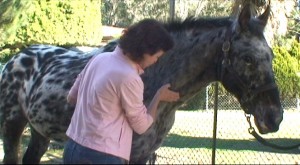

I worked my way back along Sarge’s body, relieving tension in overworked muscles. After using my hands to gently lift the muscles along his back, I kept one hand supporting his back muscles while I put my other hand on the back of his pelvis.
This seemed to give the Appaloosa a feeling of connection through his skeleton and helped him stay relaxed, focused and breathing easily.
I worked with Sarge all along the right side of his body, including his legs. The support of my hands helped release muscular stress. It was rewarding to see his deepened breathing as I gently invited movement through his ribs, spine and pelvis.
These moves not only felt pleasurable and improved his body awareness and flexibility, but could help Sarge create positive associations with being touched in the areas where the girth and saddle would contact. Sarge was content with my work on his right side, even happily letting me explore around his girth area.

I wanted to make sure that Sarge could maintain his relaxed state when I worked with him on his left side, which was his more defensive side.
To make the transition easier, I asked the Appy’s handler to take him for a short walk and then turn him around to bring him back to me.
This way I stayed in the same spot and it was Sarge who presented me with this left side. This was very different than if I had asked the horse to remain still while I walked around to the side he habitually protected.
I began by lifting Sarge’s left lower neck muscle, since he already knew what to expect from this Debono Move and he again loved it! I continued working my way back, helping Sarge gain a better awareness of his body and releasing tension.
Since Sarge is not a large horse, I was able to drape my right arm over his back. With one hand on each side of his rib cage, I gently slid his rib cage a bit forward and back, allowing Sarge to experience how his rib cage could move easily and comfortably. By working with both sides simultaneously, it distributed my pressure – and thus Sarge’s attention – to both his right and left sides at the same time.
He already knew how good this move felt on the right side, so this was a way to bridge that feeling to his left side and reduce the chance that he would reflexively protect and stiffen that side.
After several movements, I changed to an alternating rhythm, sliding first one side and then the other in light, easy movements. Moving my hands back behind the last rib on each side, I softly supported Sarge as his breathing deepened. It was exciting to see how much more of his rib cage and belly now expanded with each breath!
With the Appy relaxed, I asked for his girth. It was too soon to saddle him up that day, but I hoped to begin introducing the girth in conjunction with some Debono Moves. But Sarge was not ready for that just yet.
When the Appy saw the girth in my hands, a look of worry re-entered his eyes and his breathing became shallow. While the signs were subtle, it was essential that I notice and respect his reaction. I put the girth down and helped the Appaloosa find his happy place again.
There would be time enough to use the girth another day. I wasn’t about to rush the process and lose the ground that Sarge and I had gained. I believe in closely listening to the horse and taking the time it takes to encourage a positive response.

With Sarge’s relaxation and comfort re-established, I draped the girth over my arm but didn’t touch him with it. I continued to do hands-on moves so that he would begin to associate this piece of tack with pleasurable feelings. Accepting the girth’s presence would be the first step in re-introducing contact with it.
I ended that first session by giving Sarge gentle pressure through his pelvic bones ("seat bones" or ischial tuberosities), helping to connect his hind end to his front end. Relaxed and content, Sarge’s person took him for a short walk.
We could all see that the Appy had more movement in his rib cage and his breathing had deepened. And he had lost that worried, tight look. And as his people noted, he just seemed happier. More than one person commented that it was the most relaxed they had ever seen him. Feeling very happy myself, I arranged to return in a week for Sarge’s second session.
It was wonderfully satisfying to see that Sarge retained his relaxed countenance when I returned a week later. I first did several Debono Moves with the Appy and then introduced the saddle pad. Placing it in its normal position on his back brought a temporary wariness to Sarge until I moved the pad up to his neck. Sarge was fine with the saddle pad draped over his neck, since he didn’t have any negative associations with this placement.
My intent was to promote relaxation and pleasure as I slowly re-introduced the horse to his saddle, pad and girth. Placing the pieces of tack on him in non-habitual ways would help stimulate new, positive associations with them. If I simply tacked him up the usual way, he might have reverted back to his habitual, negative reactions.
Since Sarge had become accustomed to the presence of the girth on my arm as I worked with him, he no longer showed any negative reaction to it. This allowed me to use his girth in a new, positive way. Instead of simply being neutral and accepted, it’s even better if tack can be used to give the horse positive feelings.
Because Sarge enjoyed Sternal Coaxing (gentle movements of the sternum), I held the girth between the horse and my hand and used the girth to delicately move his sternum. Thus, the feel of the girth became associated with a pleasurable, relaxing sensation.
While I start this process by just holding the girth in my hand, I eventually work up to doing Sternal Coaxing with a girth that is attached to a saddle, even gradually tightening the girth while moving the sternum and ribs.
This allows the girthing up process to go from a tolerable experience to a pleasurable one. And very importantly, it helps the horse experience that it’s possible to freely move the ribs, sternum and spine while wearing tack. This translates to improved comfort and performance under saddle as well.
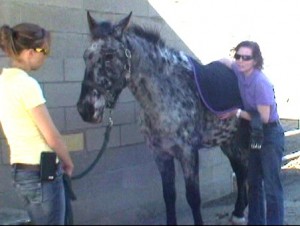
Over the second and third sessions, I used the pad, saddle and girth in various unusual ways. For example,I held the girth against Sarge’s barrel to gently slide his rib cage, which is a movement he enjoyed.
And I placed his saddle on his croup, making sure that it did not fall. I eventually put his pad and saddle in place, but without the girth. The Appy was relaxed throughout. During these sessions, I moved back and forth between his left and right sides and Sarge remained quiet and calm.
Katie, one of Sarge’s humans, continued doing Debono Moves with him after I gave Sarge his third session. Alert for even the most subtle negative reactions, Katie ensured that the Appy maintained his physical and emotional comfort while she gradually tacked him up. And she eventually put the saddle, pad and girth on him without any anxiety!
This was a real accomplishment and a testament to the care and concern that Sarge’s people have for him. They listened to their horse and took the time needed to ensure the comfort and well-being of their beloved equine friend.
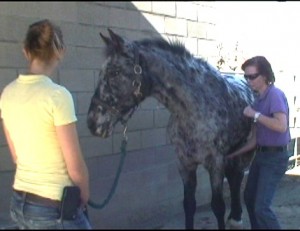
The girth can be used to gently invite movement to your horse’s sternum, a feeling that many horses find relaxing and pleasurable.
It can also help restore freedom of movement to the horse’s rib cage, resulting in easier, more efficient use of the horse’s neck, back and shoulders.

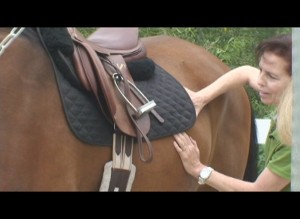
For more information on the important role of the rib cage, please read my post, The Secret to Rounding Your Horse’s Back.
Please click here to get our FREE video masterclass for riders: 3 Things You MUST Know to Ride Well.
___________________________________________________________________________________________
Footnote 1 Have you ever tightened a horse’s cinch and then, just a few minutes later, discovered that it was loose? Many equestrians erroneously refer to this as “bloating” or “blowing up with air.” Despite the common misconception, the horse is not taking a big breath and holding it. He’s contracting his abdominal muscles in an effort to control the tightening of the cinch.
_____________________________________________________________________________________________________
Does your horse object when you tighten the girth? I’d love to hear about your experiences and how you’re helping your horse enjoy the saddling process. Please leave a comment. Thank you!
Questions? Email [email protected].
____________________________________________________________________________________
This information is for general educational purposes only and is not intended to replace veterinary or professional advice. Please consult a veterinarian if you have any concerns about your horse’s health or soundness.
Horses are potentially dangerous and easily startled. You should use caution around them. Mary Debono, Gary Waskowsky and SENSE Method, Inc. disclaim all liability in connection with the use of this information.
__________________________________________________________________________

